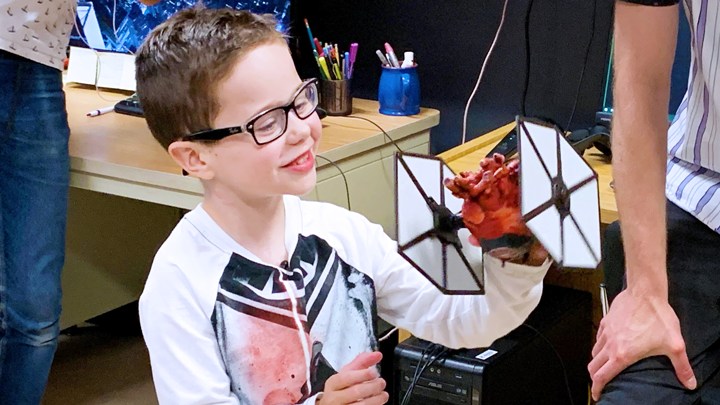
September 11, 2019

Heart transplant recipient Mason Thomas, 8, shows off a 3D model of his old heart, complete with Star Wars TIE fighter wings. The model, which allowed Mason to see what had been wrong with his heart, was the result of a collaboration between the Stollery Children’s Hospital, Academic Technologies in the Faculty of Medicine and Dentistry at the University of Alberta, the University of Alberta’s Elko Engineering Garage, and the Mazankowski Heart Institute’s Servier Virtual Cardiac Centre.
Story by Vanessa Gomez | photo by Emma Brook
The adage is ‘seeing is believing’ but, for eight-year-old Mason Thomas and members of his heathcare team, a three-dimensional model of his heart means ‘seeing is understanding.’
Mason had been asking questions about the heart transplant he received at age six. Born with hypoplastic left heart syndrome, he had been on a feeding tube and oxygen, and waited on the transplant list for more than three years.
“He’s gotten through this very well,” says Brandie Thomas, Mason’s mom. “But he struggled a lot with, ‘Why? Why me and what was wrong with my heart?’ ”
Now, thanks to a collaboration between the Stollery Children’s Hospital, Academic Technologies in the Faculty of Medicine and Dentistry at the University of Alberta, the University of Alberta’s Elko Engineering Garage, and the Mazankowski Heart Institute’s Servier Virtual Cardiac Centre, Mason is able to visualize his old heart with a detailed 3D model created using computed tomography (CT) scans, showing him what was wrong with his old heart and why he needed a new one.
Mason was given two 3D models—one depicting how his old heart functioned and another that added Star Wars TIE fighter wings to the first model—reflecting his fighting spirit and avid love of the epic space-opera series.
Creating a 3D model of a damaged heart is more than just child’s play—doctors say it will be a game-changer in the treatment of heart conditions.
“3D modelling will revolutionize healthcare in the sense that it breaks down barriers to create a shared model of care—everyone will be on the same page,” says Dr. Charles Larson, pediatric cardiac intensivist at the Stollery Children’s Hospital.
In the past, the best illustration doctors could provide prior to surgery was a sketch of the heart for patients, families and members of the care team. Now, 3D models will be able to reveal the anatomy and physiology of the heart using a variety of colours and textures.
“Because the heart is inside the body, it’s hard to get a good grasp of congenital heart defects and it can be tricky to explain to people why they need a surgery or a certain medication,” says Dr. Larson.
“With 3D modelling, parents will feel more involved and ‘expert’ in their child’s care and medical professionals will be able to learn about heart defects with better visualizations.”
According to MyHealth.Alberta.ca, hypoplastic left heart syndrome is a rare congenital heart defect in which the aorta and left ventricle of the heart are severely underdeveloped and cannot pump blood properly. As a result, lower levels of oxygen-rich blood are delivered to the body. Medicine can help treat the syndrome, but if the heart is too weak, a transplant may be necessary.
Brandie says understanding medical care and the procedures involved are important in making patients and families feel part of the healthcare team.
“If you know exactly what doctors are doing and why they’re doing it, it makes you feel that it’s being done with you instead of to you and gives you back that sense of control,” she says.
Mason’s biggest goal is to run and he enjoys staying active with swimming and gymnastics. He also loves building Lego—especially Star Wars Lego.
“I’m so grateful to the team that they thought about this,” says Brandie. “It’s important for him to get that closure and move on to the next chapter of his life with his new heart.”